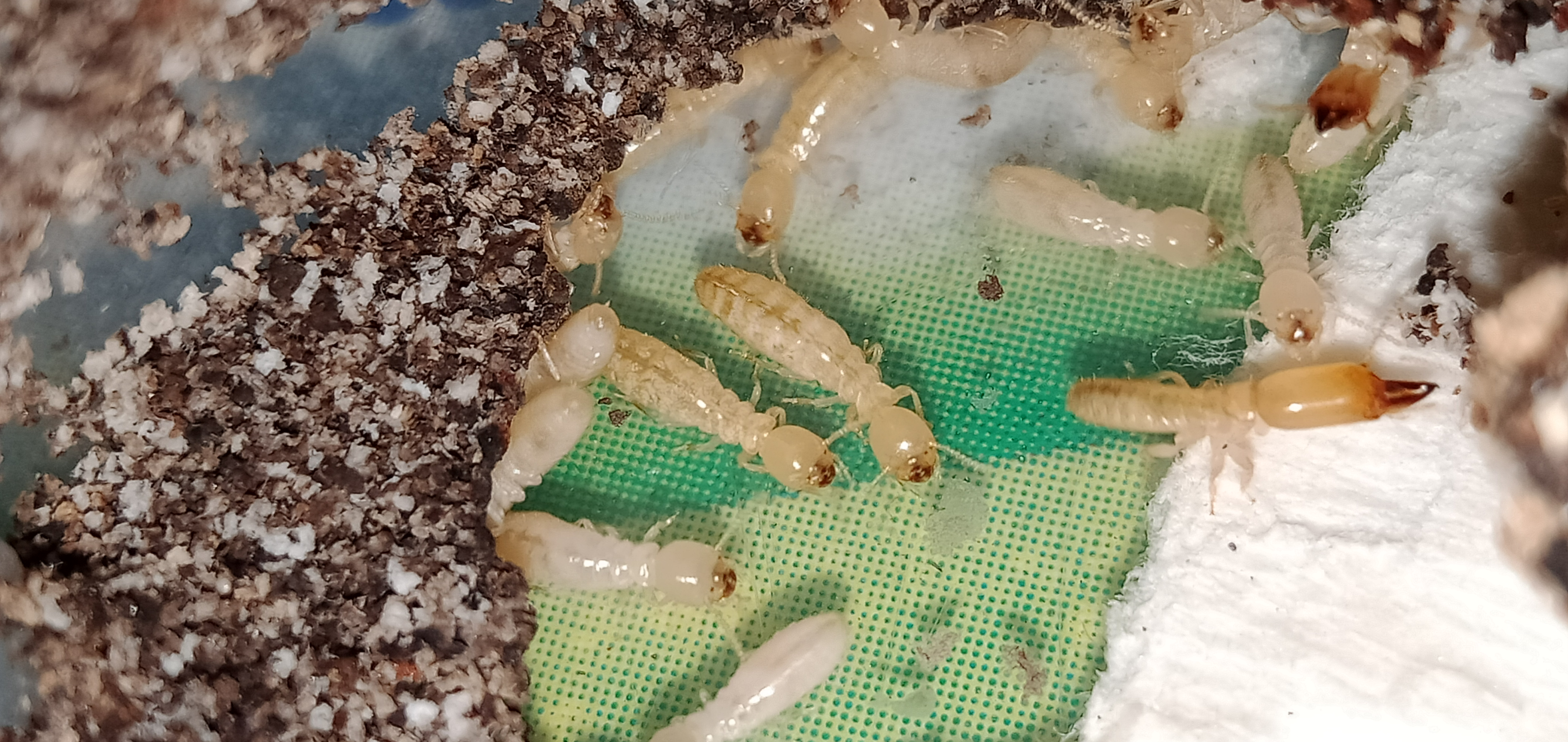Heterotermes on:
[Wikipedia]
[Google]
[Amazon]
''Heterotermes'' is a genus of subterranean



termites
Termites are a group of detritophagous eusocial cockroaches which consume a variety of decaying plant material, generally in the form of wood, leaf litter, and soil humus. They are distinguished by their moniliform antennae and the sof ...
belonging to the family Heterotermitidae
Heterotermitidae, or the subterranean termites, is a family of termites that was elevated to family level from the subfamily '' Heterotermitinae'',
formerly nested in ''Rhinotermitidae
Rhinotermitidae, sensu novo are a family (biology), family ...
. The genus has an almost cosmopolitan distribution
In biogeography, a cosmopolitan distribution is the range of a taxon that extends across most or all of the surface of the Earth, in appropriate habitats; most cosmopolitan species are known to be highly adaptable to a range of climatic and en ...
. One of their closest relatives is the '' Reticulitermes'' genus.
General overview
''Heterotermes'' are considered pests because they form large colonies and can cause severe property damage. They feed themselves by gatheringcellulose
Cellulose is an organic compound with the chemical formula, formula , a polysaccharide consisting of a linear chain of several hundred to many thousands of glycosidic bond, β(1→4) linked glucose, D-glucose units. Cellulose is an important s ...
from natural sources including dead tree logs, stumps, and branches as well as from man-made wooden structures such as buildings, books and paper.
''Heterotermes'' are considered to be highly adaptable, having a relatively fast growth rate in mature colonies with good conditions. They are found in dry and humid wooded areas, such as the West Indies and the Bahamas, except for '' Heterotermes aureus'', which has been found in Northwestern Mexico
Mexico, officially the United Mexican States, is a country in North America. It is the northernmost country in Latin America, and borders the United States to the north, and Guatemala and Belize to the southeast; while having maritime boundar ...
and the Southwestern United States
The Southwestern United States, also known as the American Southwest or simply the Southwest, is a geographic and cultural list of regions of the United States, region of the United States that includes Arizona and New Mexico, along with adjacen ...
. ''Heterotermes'' show relatively fast neotenic
Neoteny (), also called juvenilization,Montagu, A. (1989). Growing Young. Bergin & Garvey: CT. is the delaying or slowing of the physiological, or somatic, development of an organism, typically an animal. Neoteny in modern humans is more signif ...
formation within the colony and are only observed to have the nymphoid neotenic caste as a secondary reproductive.
They are similar in appearance to '' Reticulitermes'', but ''Heterotermes'' soldiers are smaller and exhibit a mandible
In jawed vertebrates, the mandible (from the Latin ''mandibula'', 'for chewing'), lower jaw, or jawbone is a bone that makes up the lowerand typically more mobilecomponent of the mouth (the upper jaw being known as the maxilla).
The jawbone i ...
with a curved tip and a base area that is straighter than that of ''Reticulitermes''.
Castes
Primary reproductives
The alates of many ''Heterotermes'' and ''Reticulitermes'' are very similar in morphology. However, many ''Heterotermes''gynes
The gyne (, from Greek γυνή, "woman") is the primary reproductive female Caste (biology), caste of social insects (especially ants, wasps, and bees of order Hymenoptera, as well as termites). Gynes are those destined to become queens, wherea ...
are more lightly pigmented (color range is usually pale yellow-brown to orange-brown) than ''Reticulitermes''. They are between 7 and 11 millimeters in length. A colony usually only consists of one pair of primary reproductives, but they are occasionally found to have more than one reproductive pair.

Secondary reproductives
The only type of secondary reproductive found in ''Heterotermes'' are nymphoid neotenic individuals. They usually arise in case of colony isolation or the death of primary reproductives. They start to develop from nymphs around their thirdinstar
An instar (, from the Latin '' īnstar'' 'form, likeness') is a developmental stage of arthropods, such as insects, which occurs between each moult (''ecdysis'') until sexual maturity is reached. Arthropods must shed the exoskeleton in order to ...
. Older nymphs of this caste are also found to molt back into a nymphoid neotenic in case they are needed. A colony can have multiple nymphoid neotenic pairs that become physogastric
Physogastrism or physogastry is a characteristic of certain arthropods (mostly insects and mites), where the abdomen is greatly enlarged and membranous. The most common examples are the "queens" of certain species of eusocial insects such as termit ...
within the first few weeks to produce eggs. Similar to workers, they lack visible eyes and are usually lightly pigmented which gives them a light orange tint.


Workers and soldiers
Workers make up the majority of a colony alongside soldiers. Workers perform tasks such as gathering food, expanding the nest, and caring for reproductives and their brood, while soldiers perform the task of defending the nest against intruders. Soldiers will excrete a light grey-tinted sticky liquid when disturbed, and are also found to bump their heads into nest walls to alert fellow colony members about arriving danger.Species
*'' Heterotermes aethiopicus'' *'' Heterotermes assu'' *'' Heterotermes aureus'' *'' Heterotermes balwanti'' *'' Heterotermes brevicatena'' *'' Heterotermes cardini'' *'' Heterotermes ceylonicus'' *'' Heterotermes convexinotatus'' *'' Heterotermes crinitus'' *'' Heterotermes eocenicus'' *'' Heterotermes ferox'' *'' Heterotermes gertrudae'' *'' Heterotermes indicola'' *'' Heterotermes intermedius'' *'' Heterotermes longicatena'' *'' Heterotermes longiceps'' *'' Heterotermes maculatus'' *'' Heterotermes malabaricus'' *''Heterotermes occiduus
''Heterotermes'' is a genus of subterranean termites belonging to the family Heterotermitidae. The genus has an almost cosmopolitan distribution. One of their closest relatives is the ''Reticulitermes'' genus.
General overview
''Heterotermes'' ar ...
''
*'' Heterotermes omanae''
*'' Heterotermes pamatatensis''
*'' Heterotermes paradoxus''
*'' Heterotermes perfidus''
*'' Heterotermes philippinensis''
*'' Heterotermes platycephalus''
*'' Heterotermes primaevus''
*'' Heterotermes sulcatus''
*'' Heterotermes tenuior''
*'' Heterotermes tenuis''
*'' Heterotermes vagus''
*'' Heterotermes validus''
*'' Heterotermes wittmeri''
References
{{Taxonbar, from=Q13582619 Rhinotermitidae Termite genera